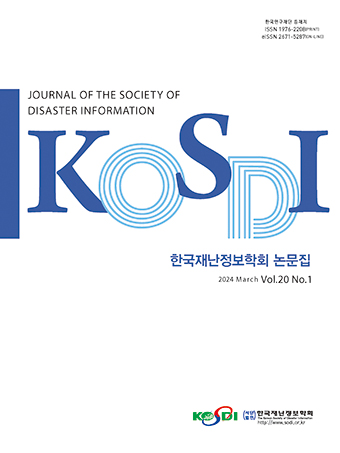Original Article
Abstract
References
Information
Purpose: In this study, the effect of changes in the variables related to water droplets on the spray density on the floor in the analysis of the water mist fire protection system using FDS was analyzed. Method: When the spray of the water mist nozzle was analyzed in FDS, Particles Per Seconds, Particle Velocity, Size Distribution, and Spray Pattern Shape that can be set in relation to droplets were input to review the analyzed results. Result: In the analysis results, when the number of particles per second was set above a certain value, the spray density of the floor was similar. In the case of Particle Velocity, as the velocity decreases, the spray density of the central portion increases but decreases at a distance of 0.15m or more. From the analysis of the change in the size distribution function, it was found that an increase in the γ value increases the spray density of the central part, but the value at a remote location decreases. Compared to the result of applying the Gaussian distribution, the median value decreases dramatically when the uniform distribution is applied, but the value at the adjacent position increases. Conclusion: Variables related to the droplet properties of the FDS affect the spray density of the floor. Therefore, in order to increase the reliability of results before performing analyses such as fire suppression or cooling, a sufficient review of input variables is required.
연구목적: 본 연구는 미분무 소화설비의 FDS모델링 수행에 있어 액적과 관련된 변수의 설정 변화가 살수밀도에 미치는 영향을 알아보았다. 연구방법: 미분무 노즐의 살수 현상을 FDS에서 해석할 경우 액적과 관련하여 설정할 수 있는 항목 중 초당액적수, 액적속도, 입경분포함수, 분사패턴형태의 값을 입력하여 분석된 결과를 검토하였다 연구결과: 분석결과에서, 초당미립자 수 설정은 일정 값 이상이 되면 유사한 바닥면의 살수밀도를 보여주었다. 액적속도는 낮아짐에 따라 중심부분의 살수밀도를 높이지만 0.15m 이상 떨어진 거리에서는 낮아짐을 알 수 있었다. 입경분포함수의 변화에 대한 분석에서, γ값의 증가는 중심부분의 살수밀도의 증가를 가져오지만, 떨어진 위치에서의 값은 감소를 가져온다는 점을 알 수 있었다. 가우시안 분포를 적용한 결과에 비하여 균등분포를 적용하는 경우 중앙값은 극적으로 낮아지지만 인접위치에서의 값은 증가함을 보여준다. 결론: FDS의 액적특성에 관련된 변수들은 각각 바닥면의 살수밀도에 영향을 준다. 그러므로 화재 진압이나 냉각 등의 해석에 들어가기 전 신뢰성을 확보하기 위하여 입력변수에 대한 면밀한 검토가 필요하다.
- Ko, G.H. (2014). "Estimation of fds prediction performance on the operation of water-mist." Journal of the Korea Academy Industrial Cooperation Society, Vol. 15, No. 8 pp. 4809-4814. 10.5762/KAIS.2014.15.8.4809
- Kwak, J.H., Kim, D.S., Park, M.H., Kim, Y.J. (2014). "Effect of water mist droplet size on the insulation destruction of electric cables." Proceedings of 2014 Autumn Annual Conference, Korean Institutes of Fire Science & Engineering, Samcheok, pp. 31-32.
- Lee, J.H. (2019). "Numerical analysis of the effects of droplets characteristics of water spray on fire suppression." Fire Science and Engineering, Vol. 33. No. 6, pp. 1-8. 10.7731/KIFSE.2019.33.6.001
- McGrattan, K., Hostikka, S., Floyd, J., McDermott, R., Vanella, M. (2020). Fire Dynamics Simulator User's Guide, National Institute of Standards and Technology, Gaithersburg, Maryland, U.S.
- Roh, S.K., Kim, D.C., Ham, E.G. (2012). "The study of fire suppression capability of low pressure water-mist system for wooden cultural properties." Journal of the Korea Society of Disaster Information, Vol. 8. No. 4, pp 401-410.
- Vaari, J., Hostikka, S., Sikanen, T., Paajanen, A. (2012). "Numerical simulations on the performance of water-based fire suppression systems." VTT Technical Research Centre of Finland., Finland, pp.137-139.
- Publisher :The Korean Society of Disaster Information
- Publisher(Ko) :한국재난정보학회
- Journal Title :Journal of the Society of Disaster Information
- Journal Title(Ko) :한국재난정보학회논문집
- Volume : 17
- No :1
- Pages :120-127
- DOI :https://doi.org/10.15683/kosdi.2021.3.31.120




 Journal of the Society of Disaster Information
Journal of the Society of Disaster Information







